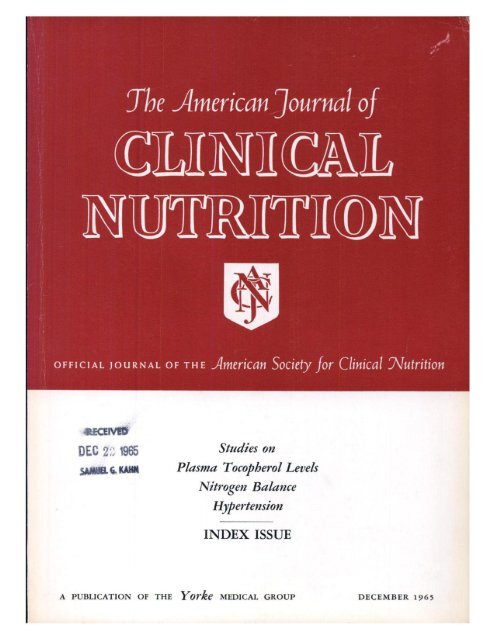在一项随机、交叉、对照喂养研究中,不同血糖负荷饮食对肠道微生物群代谢可塑性的影响
IF 6.9
1区 医学
Q1 NUTRITION & DIETETICS
引用次数: 0
摘要
背景:以低血糖、最低限度加工的植物性食品为特征的饮食模式与几种慢性疾病的低风险相关。目的:评价低糖负荷(LGL)与高糖负荷(HGL)饮食模式对粪便细菌群落结构和代谢的影响。方法:本交叉对照喂养研究的参与者为健康男性和女性(n=69)。我们利用16S rRNA基因、宏基因组和元转录组测序以及生物信息学分析,鉴定了属、种、代谢途径和细菌酶的基因和转录本。结果:饲料显著提高了161个属中13个属(padjadj=0.002)的丰度,但饲料显著提高了161个属中α和β多样性测量的总体群落结构,而l -赖氨酸生物合成途径的表达量(β =0.20, SE=0.05, 95% CI (0.09, 0.30);padj = 0.03);在LGL日粮中得到了丰富不同饲粮(MiRKAT, padj=0.035)表达的糖活性酶(CAZymes) β多样性差异显著,高gl饲粮为阳性(β=0.20, SE=0.09, 95% CI(0.02, 0.39)),低gl饲粮为阴性(β= -0.23, SE=0.09, 95% CI(-0.40, -0.06))。结论:在健康人群中,饮食影响微生物代谢和酶活性,但不影响肠道微生物群的整体多样性。这强调了饮食成分在激活特定细菌基因表达及其对宿主代谢的影响中的相关性。该试验在clinicaltrials.gov注册为NCT00622661。本文章由计算机程序翻译,如有差异,请以英文原文为准。
Metabolic plasticity of the gut microbiome in response to diets differing in glycemic load in a randomized, crossover, controlled feeding study
Background
Dietary patterns characterized by low glycemic, minimally processed plant foods are associated with lower risk of several chronic diseases.
Objectives
Evaluate the effects of a low glycemic load (LGL) compared with a high glycemic load (HGL) dietary pattern on stool bacterial community structure and metabolism.
Methods
Participants in this crossover-controlled feeding study were healthy men and women (n = 69). We identified genera, species, and genes and transcripts of metabolic pathways and bacterial enzymes using 16S rRNA gene, metagenomic and metatranscriptomic sequencing, and bioinformatic analysis.
Results
Overall community structure measured by alpha and beta diversity was not significantly different across the diets, although diet did significantly increase the abundance of 13 of 161 genera (Padj < 0.05) and 5 species in the LGL diet and 7 species in the HGL diet. Gene expression in the hexitol fermentation pathway (β = −1.15; SE = 0.24; 95% confidence interval [CI]: −1.63, −0.67; Padj = 0.002) was significantly higher in the HGL diet, whereas expression in the L-lysine biosynthesis pathway (β = 0.20; SE = 0.05; 95% CI: 0.09, 0.30; Padj = 0.03) was enriched in the LGL diet. The beta diversity of expressed carbohydrate-active enzymes (CAZymes) was significantly different between the diets (MiRKAT, P < 0.001). CAZymes enriched in the HGL diet reflected dietary additives, whereas CAZymes enriched in the LGL diet reflected diverse phytochemical intake. There was a significant interaction between homeostasis model assessment of insulin resistance (HOMA-IR) and the coenzyme A biosynthesis I pathway involved in bacterial fatty acid biosynthesis (Padj = 0.035), which was positive in the HGL diet (b = 0.20; SE = 0.09; 95% CI: 0.02, 0.39) and negative in the LGL diet (β = −0.23; SE = 0.09; 95% CI: −0.40, −0.06).
Conclusions
In healthy humans, diet impacts microbial metabolism and enzymatic activity but not the overall diversity of the gut microbiome. This emphasizes the relevance of dietary components in activating expression of specific bacterial genes and their impact on host metabolism.
This trial was registered at clinicaltrials.gov as NCT00622661.
求助全文
通过发布文献求助,成功后即可免费获取论文全文。
去求助
来源期刊
CiteScore
12.40
自引率
4.20%
发文量
332
审稿时长
38 days
期刊介绍:
American Journal of Clinical Nutrition is recognized as the most highly rated peer-reviewed, primary research journal in nutrition and dietetics.It focuses on publishing the latest research on various topics in nutrition, including but not limited to obesity, vitamins and minerals, nutrition and disease, and energy metabolism.
Purpose:
The purpose of AJCN is to:
Publish original research studies relevant to human and clinical nutrition.
Consider well-controlled clinical studies describing scientific mechanisms, efficacy, and safety of dietary interventions in the context of disease prevention or health benefits.
Encourage public health and epidemiologic studies relevant to human nutrition.
Promote innovative investigations of nutritional questions employing epigenetic, genomic, proteomic, and metabolomic approaches.
Include solicited editorials, book reviews, solicited or unsolicited review articles, invited controversy position papers, and letters to the Editor related to prior AJCN articles.
Peer Review Process:
All submitted material with scientific content undergoes peer review by the Editors or their designees before acceptance for publication.

 求助内容:
求助内容: 应助结果提醒方式:
应助结果提醒方式:


